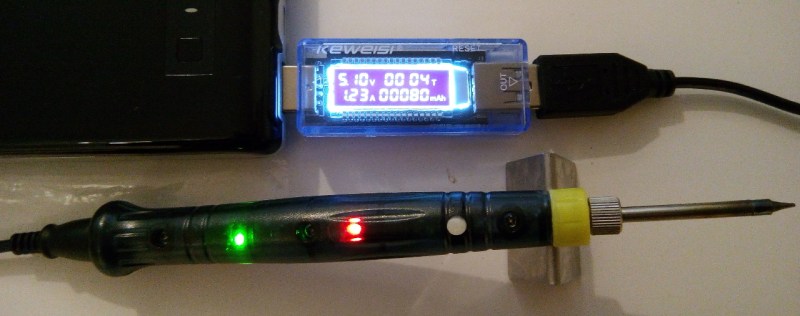Seeing the popularity of the TS-100 soldering iron, GitHub user [ole00] found himself desirous of a few of its features, but was put off by its lack of a power supply. What is a hacker to do? Find a cheaper option, and hack it into awesomeness.
[ole00] stumbled across the inexpensive ZD-20U and — despite a handful (sorry!) of issues — saw potential: it’s compact, lightweight, and powered via a USB power cable. Wanting to use as much of the ZD-20U’s original board as possible, the modifications were restricted to a few trace cuts and component swaps. The major change was swapping out the 555 timer IC controlling the iron with am ATtiny13a MCU to give it a bit more control.
[ole00] has also replaced the awkward touch-sensitive stud with a push button, changed the LED’s behaviour to that of a temperature indicator, and configurable temperature profiles and heating cycles. A full project breakdown can be found on their GitHub page.
If you do have a TS-100, keep it protected!
















I can hear the complaints already; someone replaced a 555 for a micrcontroller!! The horror..
/me gets some popcorn and enjoys the show..
Meh. “555 vs ATtiny” is _soooo_ 2016.
sounds really sweet and there’s not much room for down sizing when it comes to atmel chips and the attiny13A.
Go Attiny10 :D
Oh this is a great addition to my ghetto hot tweezer setup.
https://pbs.twimg.com/media/DQOHslNVwAA3sZc.jpg
https://pbs.twimg.com/media/DQOHvG-V4AMGTKs.jpg
FLAWLESS VICTORY
this is so awesome.
CURSES! I had this exact hack in mind but had backburnered it until I finished the emag rifle retrofit.
Would the USB iron emit enough heat for lead free soldering?
That tip really needs tinning.
I guess the tip of this cheap iron CHANGES RESISTANCE WITH TEMPERATURE… What about powering it off for fraction of second and using attiny to measure that resistance, so we can have real feedback for CLOSED LOOP pid temperature control. Maybe we can just use shunt to measure current thru tip, while measuring voltage, so we can calculate the resistance and therefore temperature of the tip.
We can even manage to calibrate the thing using that power transistor as a inprecise current sensing shunt. I think i saw some battery protection circuits doing just that.
Crap. I took mine apart, and it seems to be a different circuit board. Most of it will work, but there are some critical differences that I’ll have to work out. (I would post a photo, but don’t know how to here.)
II bought mine today and improved it with cap of 82pF on diode (parallel) on pin2, now it’s not so hyper sensitive, original circuit, no mod . This Attiny mod doesn’t measure temperature at all, so wouldn’t it be easier to get this NE555 working with regulated PWM with potentiometer, or fixed value? Actually this mod here does it but allows you to choose modes.Anyway probably you set it once and that’s it. Of course if you redesign it for fixed PWM then you would loose button function